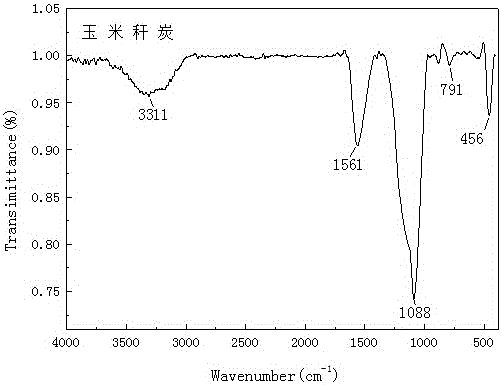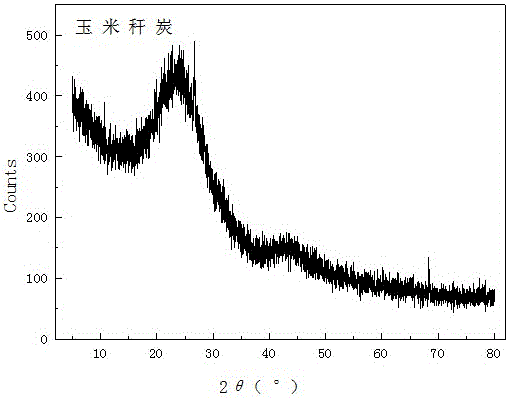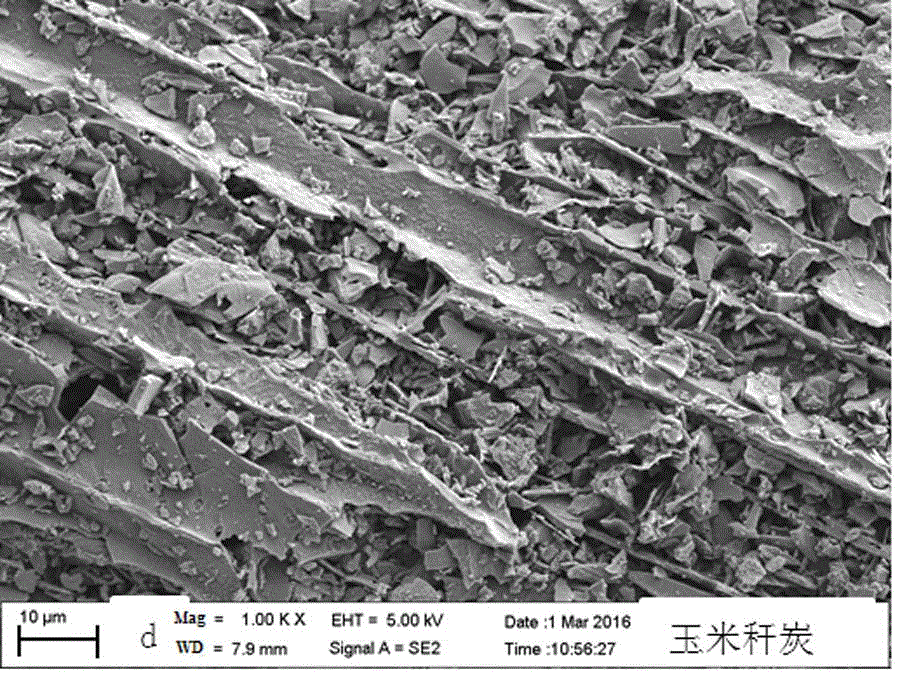Corn stalk biochar, method for removing sulfonamide antibiotics in water by using corn stalk biochar and application of corn stalk biochar
A corn stalk and biochar technology, applied in chemical instruments and methods, water pollutants, other chemical processes, etc., can solve the problems of inability to achieve adsorption effect, difference in adsorption performance, human health hazards, etc., and achieve resource utilization, Low ash content, the effect of solving environmental problems
- Summary
- Abstract
- Description
- Claims
- Application Information
AI Technical Summary
Problems solved by technology
Method used
Image
Examples
Embodiment 1
[0039] A kind of corn stalk biochar, it is prepared through the following steps:
[0040] 1) Wash the corn stalks, air-dry them for 2 days, put them in an oven at 60°C for 12 hours, and then use a grinder to crush them to below 2 cm;
[0041] 2) Wrap the minced corn stalks with tin foil and place them in a porcelain crucible, cover the lid and put it into a tube-type atmosphere furnace, turn on N 2 , using temperature programming and raising the temperature to the target temperature of 700°C at a rate of 10°C / min, and then maintaining it for 3h;
[0042] 3) After naturally cooling to room temperature in the furnace, take it out and grind it with a mortar and pass through a 60-mesh sieve;
[0043] 4) Treat the sieved product with 1mol / L HCl for 4 hours, filter it with suction, wash with distilled water until the lotion is neutral, put it in an oven at 80°C for 24 hours, cool to room temperature and pass through a 100-mesh sieve to obtain the final product corn straw biochar. ...
Embodiment 2
[0046] The corn stalk biochar obtained in Example 1 was used as an adsorbent to treat slightly polluted water containing sulfadiazine, and an adsorption experiment was carried out in a 100 mL stoppered glass bottle. Among them, the mass ratio of corn stalk biochar to sulfadiazine-containing aqueous solution is 1:100, the adsorption temperature is 25±2°C, the initial concentration of sulfadiazine is 1-20mg / L, the adsorption time is 3h, and the solution after adsorption equilibrium The pH value is about 5.60, and the treatment results are shown in Table 1.
Embodiment 3
[0048] The corn stalk biochar obtained in Example 1 was used as an adsorbent to treat the slightly polluted water containing sulfachloropyridazine, and an adsorption experiment was carried out in a 100 mL stoppered glass bottle. Among them, the mass ratio of corn stalk biochar to the aqueous solution containing sulfachloropyridazine was 1:200, the adsorption temperature was 25±2°C, the initial concentration of sulfachloropyridazine was 1-20mg / L, and the adsorption time was 3h. The pH value of the solution after adsorption equilibrium is about 5.20, and the treatment results are shown in Table 1.
[0049] Table 1 Summary table of corn straw biochar treatment results.
[0050] Pollutants
PUM
| Property | Measurement | Unit |
|---|---|---|
| length | aaaaa | aaaaa |
Abstract
Description
Claims
Application Information
 Login to View More
Login to View More - R&D
- Intellectual Property
- Life Sciences
- Materials
- Tech Scout
- Unparalleled Data Quality
- Higher Quality Content
- 60% Fewer Hallucinations
Browse by: Latest US Patents, China's latest patents, Technical Efficacy Thesaurus, Application Domain, Technology Topic, Popular Technical Reports.
© 2025 PatSnap. All rights reserved.Legal|Privacy policy|Modern Slavery Act Transparency Statement|Sitemap|About US| Contact US: help@patsnap.com



